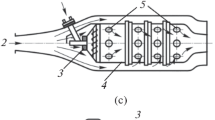Abstract
This is the second paper in a series of publications summarizing the international experience in the development of low-emission combustors (LEC) for land-based, large (above 250 MW) gas-turbine units (GTU). The purpose of this series is to generalize and analyze the approaches used by various manufacturers in designing flowpaths for fuel and air in LECs, managing fuel combustion, and controlling the fuel flow. The efficiency of advanced GTUs can be as high as 43% (with an output of 350–500 MW) while the efficiency of 600–800 MW combined-cycle units with these GTUs can attain 63.5%. These high efficiencies require a compression ratio of 20–24 and a temperature as high as 1600°С at the combustor outlet. Accordingly, the temperature in the combustion zone also rises. All the requirements for the control of harmful emissions from these GTUs are met. All the manufacturers and designers of LECs for modern GTUs encounter similar problems, such as emissions control, combustion instability, and reliable cooling of hot path parts. Methods of their elimination are different and interesting from the standpoint of science and practice. One more essential requirement is that the efficiency and environmental performance indices must be maintained irrespective of the fuel composition or heating value and also in operation at part loads below 40% of rated. This paper deals with Mitsubishi Series M701 GTUs, F, G, or J class, which have gained a good reputation in the power equipment market. A design of a burner for LECs and a control method providing stable low-emission fuel combustion are presented. The advantages and disadvantages of the use of air bypass valves installed in each liner to maintain a nearly constant air to fuel ratio within a wide range of GTU loads are described. Methods for controlling low- and high-frequency combustion instabilities are outlined. Upgrading of the cooling system for the wall of a liner and a transition piece is of great interest. Change over from effusion (or film) cooling to convective steam cooling and convective air cooling has considerably increased the GTU efficiency.
Similar content being viewed by others
References
K. Tsukagoshi, J. Masada, A. Muyama, Y. Iwasaki, and E. Ito, “Operating status of uprating gas turbines and future trend of gas turbine development,” Tech. Rev. - Mitsubishi Heavy Ind. 44 (4), 1–6 (2007).
“Simple cycle GTW design ratings; combined cycle GTW design ratings,” Gas Turbine World 47 (1) (2017). http://www.gasturbineworld.com.
S. Hada, M. Yuri, J. Masada, E. Ito, and K. Tsukagoshi, “Evolution and future trend of large frame gas turbines a new 1600 degree C, J class gas turbine,” in Proc. ASME Turbo Expo 2012: Turbine Technical Conference and Exposition, Copenhagen, June 11–15, 2012, paper no. GT2012-68574.
K. Tsukagoshi, K. Tanaka, K. Nishida, S. Akamatsu, H. Kishida, K. Saitoh, and K. Sato, “Development of air cooled combustor for Mitsubishi G class gas turbine,” in Proc. ASME 2011 Power Conf., Denver, CO, July 12–14, 2011, paper no. POWER2011-55387.
K. Tsukagoshi, H. Arimura, K. Tanaka, K. Nishida, T. Konishi, S. Akamatsu, H. Kishida, and K. Sato, “Development of air cooled combustor for Mitsubishi G class gas turbine,” in Proc. ASME Turbo Expo 2010: Power for Land, Sea and Air, Glasgow, June 14–18, 2010, paper no. GT2010-2010-22864.
S. Tanimura, M. Nose, K. Ishizaka, S. Takiguchi, and J. Rodriguez, “Advanced dry low NOx combustor for Mitsubishi G class gas turbines,” in Proc. ASME Turbo Expo 2008: Power for Land, Sea, and Air, Berlin, June 9–13, 2008, paper no. GT2008-50819.
T. Ai, H. Arimura, C. Koeneke, and Y. Hyakutake, “Development of an air cooled G class gas turbine (the M501GAC),” in Proc. ASME Turbo Expo 2009: Power for Land, Sea, and Air, Orlando, FL, June 8–12, 2009, paper no. GT2009-60321.
K. Tanaka, W. Akizuki, and K. Nishida, “Gas turbine combustor technology contributing to environmental conservation,” Tech. Rev. - Mitsubishi Heavy Ind. 46 (2), 6–12 (2009).
H. Yamazaki, Y. Nishimura, M. Abe, et al., “Development of next generation gas turbine combined cycle system,” in Proc. ASME Turbo Expo 2016: Turbomachinery Technical Conf. and Expo., Seoul, June 13–17, 2016, paper no. GT2016-56322.
Creating Value for the World DOOSAN Gas Turbines. http://www.doosanheavy.com.
H. Yamazaki, Y. Nishimura, M. Abe, K. Takata, S. Hada, and J. Masada, “Development of next generation gas turbine combined cycle system,” in Proc. ASME Turbo Expo 2016: Turbomachinery Tech. Conf. and Expo., Seoul, June 13–17, 2016, paper no. GT2016-56322
Author information
Authors and Affiliations
Corresponding author
Additional information
Original Russian Text © L.A. Bulysova, V.D. Vasil’ev, A.L. Berne, M.N. Gutnik, A.V. Ageev, 2018, published in Teploenergetika.
Rights and permissions
About this article
Cite this article
Bulysova, L.A., Vasil’ev, V.D., Berne, A.L. et al. International Experience in Developing Low-Emission Combustors for Land-Based, Large Gas-Turbine Units: Mitsubishi Heavy Industries’ Equipment. Therm. Eng. 65, 287–293 (2018). https://doi.org/10.1134/S0040601518050026
Received:
Accepted:
Published:
Issue Date:
DOI: https://doi.org/10.1134/S0040601518050026



